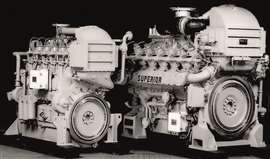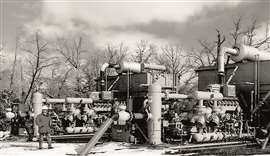Superior 1700G gas engines
April 09, 2024
The Cornerstones of Compression series has highlighted many significant products over more than 160 years of continuous progress. However, there were also some great engine and compressor ideas that were unsuccessful. This brief Cornerstones of Compression corollary series features several development failures. By Norm Shade
 The 1200 rpm Superior 500 hp (373 kW) 1706G2 and 800 hp (597 kW) 1712G engines weighed only 6400 lb. (2903 kg) and 11,800 lb. (5352 kg), respectively, a power to weight ratio that was almost 93% less than big horizontal engines that were prevalent many decades earlier.
The 1200 rpm Superior 500 hp (373 kW) 1706G2 and 800 hp (597 kW) 1712G engines weighed only 6400 lb. (2903 kg) and 11,800 lb. (5352 kg), respectively, a power to weight ratio that was almost 93% less than big horizontal engines that were prevalent many decades earlier.
The Superior Gas Engine Company of Springfield, Ohio sold its first gas engine in 1893. The company went on to develop and manufacture lines of diesel and gas engines that were used throughout industrial, oil field and marine applications.
After World War II, the company saw a new opportunity for large gas engines. Based on its successful Model 40 diesels, the Superior G825 gas engine series was introduced in 1952. White Motor Company purchased the company in 1955 for its diesel engine business, but it also gradually modernized its gas engine designs. With an eye on expanding the market for gas engines, in 1960 White introduced a line of reciprocating compressors, matched to its engines. The division name changed to White Superior in 1965, and the packaged engine and compressor sets – known as “Whites” - dominated the field in the early years of high-speed units. White was the only company offering single-source responsibility for high-speed engines, compressors, packages, parts and service. The Superior division was acquired by Cooper Industries in 1976.
More competition
However, in the 1980s, stiffer competition was looming, as Caterpillar was introducing new G3500 gas engines based on its successful D3500 diesel engine series. These 310 to 1085 hp (231 to 809 kW) engines operated at 1200 rpm, and when coupled with new Ariel compressors that had been designed to match the higher engine speed, resulted in lower cost compressor packages than those built with the 900 rpm Superior units. To make matters worse, Waukesha continued to improve its VHP series for operation at 1200 rpm.
So, Cooper began looking for a high-speed diesel engine to license for adaptation as a new generation of Superior gas engines. Cooper determined that the new SU diesel series developed by Japan’s Mitsubishi Heavy Industries (MHI) was an excellent platform on which to develop a line of 1200 rpm gas engines from 1200 to 3200 hp (895 to 2386 kW). As discussions on an SU license agreement progressed, Cooper also became aware of MHI’s successful SR diesel engine series, which was manufactured in fairly high production volumes for marine and industrial markets. SR diesels had been successful up to 1800 rpm, so application at 1200 rpm was very conservative. With an exchange rate of over 250 Yen/$US in 1985, a commercially attractive agreement emerged wherein Cooper could develop the SR engine into spark-ignited natural gas engines using SR engine short blocks that were manufactured in MHI’s modern factory in Sagamihara, Japan. A license agreement in 1986 set the six-, 12- and 16-cylinder short block prices in Yen at a level that was attractive to both companies based on the exchange rate.
 The first 12-cylinder 1712G vee engines entered service in 1993, including these two units driving Superior RAM54 compressors.
The first 12-cylinder 1712G vee engines entered service in 1993, including these two units driving Superior RAM54 compressors.
Cooper’s Superior division was already developing its 5 in. (127 mm) stroke RAM reciprocating compressor line for matching 1200 and 1500 rpm drivers, so having a competitive 1200 rpm gas engine for the market under 1000 hp (745 kW) was especially attractive.
As the new Caterpillar G3500 series was gaining rapid acceptance with Ariel compressors, it became increasingly important for Superior to preserve its market. A large development team was assembled to simultaneously complete the development of three new compressor series complete with new cylinders as well as seven new gas engine platforms. This was a Herculean task, requiring a tremendous investment, but progress was steady, first on the new compressors, and then on the more challenging gas engines.
First model released
The new gas engine series based on the SR was branded the 1700G, which related to its 6.69 in. (170 mm) cylinder bore diameter. After extensive lab testing, the first model 1706G2 engines were introduced for field trials in late 1991. This model utilized a longer 8.66 in. (220 mm) stroke than the other MHI SR models. The four-stroke turbocharged and intercooled six-cylinder inline gas engine had a rating of 500 hp (373 kW) at 1200 rpm. It utilized the MHI 6SR2 running gear, frame, and cylinder heads. The top end was otherwise redeveloped to provide an efficient gas engine based on Superior’s CleanBurn technology.
The second model developed was the 12-cylinder 1712G vee engine, which had a 7.09 in. (180 mm) stroke and a rating of 800 hp (597 kW) at 1200 rpm. It utilized the MHI 12SR running gear and frame, but the top end, including cylinder heads, was a completely new design. This extra design and development effort took longer and increased the cost; however, the resulting performance was exceptional. The first 1712G engines entered service in April 1993.
The 1706G2 and 1712G engines weighed only 6400 lb. (2903 kg) and 11,800 lb. (5352 kg), respectively, a power to weight ratio that was almost 93% less than the big Cooper horizontal engines that were prevalent many decades earlier. The compact engines had reasonably good fuel tolerance while achieving very competitive fuel and exhaust emissions rates without requiring catalytic converters. A state-of-art electronic PLC-based control system was a key development that was essential to the new gas engine’s efficiency and low emissions. However, it was also an Achilles’ heel. Field maintenance technicians in upstream applications, where these engines were applied, lacked enough training and laptop computers for tuning and diagnosing the controls. So, when a unit had problems, there was often a long delay until a qualified technician arrived. This problem was eventually resolved, and the increasingly reliable field fleet gained acceptance, although Caterpillar engine acceptance was several years ahead by then.
But with Japan enjoying unprecedented growth and financial strength compared to the U.S., the once favorable exchange rate had plunged to 125 Yen/$US by 1988, increasing the cost of the MHI short blocks by 100% in just two years. Despite extensive efforts by Superior and MHI to reduce the cost and optimize scope, the 1700G program was doomed as the exchange rate fell to 85 Yen/$US by 1995.
The final model was a 1067 hp (796 kW) 1716G vee engine that was still being assembled when the company suspended 1700G production in 1998. Only 22 of the 1700G engines were produced, most of which were 1706G2 models.
MAGAZINE
NEWSLETTER

CONNECT WITH THE TEAM






